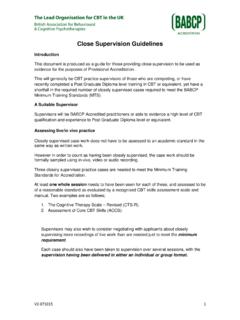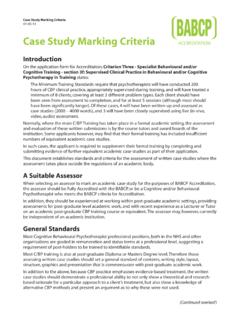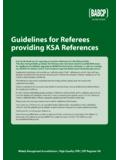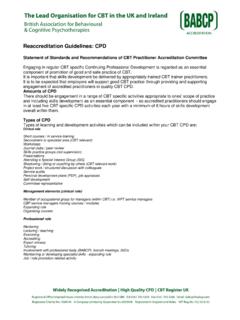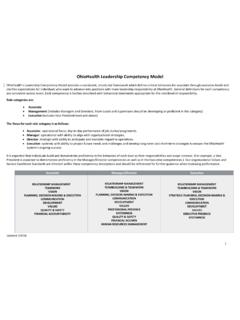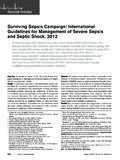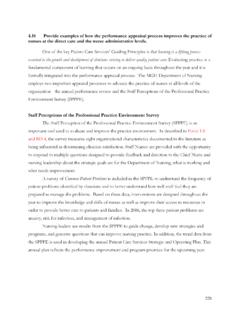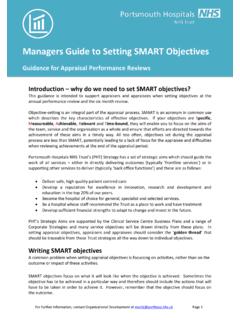Transcription of Reach Out - BABCP | British Association for …
1 1 David Richards et al 2010, 1st editionReach Out National Programme Supervisor Materials to Support the Delivery of Training for Psychological Wellbeing Practitioners Delivering Low Intensity InterventionsDavid Richards, Marie Chellingsworth, Roslyn Hope, Graham Turpin and Mark Whyte1st edition2 David Richards et al 2010, 1st editionThis publication was commissioned by the National IAPT Programme to support training courses for practitioners delivering LI interventions. It is therefore recommended for use by those courses to facilitate consistent and high quality standards across England. Further copies of this publication can be downloaded from Acknowledgements 4 Introduction 6 The role of the Psychological 5 Wellbeing Practitioner Supervision 7C8 Supervision Checklist 14A7 Supervision Simulation 17 AssessmentI1 I2 24 Low-intensity treatment 28interventions Record keeping 51 Practise outcomes 54 Reference 57 ContentsFirst published in the UK by Rethink Welcome Team 0845 456 0455 Email Charity Number 271028 For more information about Rethink publications and other products on mental health, please visit or call 0845 456 0455.
2 David Richards 2010, 1st editionThe right of David Richards to be identified as the author of this work has been asserted by him in accordance with the Copyright, Designs and Patent Act, rights reserved. This book has been produced on the condition that it shall not, by way of trade or otherwise, be lent, sold, hired out or otherwise circulated in any form binding or cover other than that in which it is published and without a similar condition including this condition being imposed on the subsequent the source is fully acknowledged, all materials in this work may be freely copied, but for teaching and clinical purposes of the content in this guide is reproduced with permission from Richards, D. and Whyte, M. (2008). Reach Out: National Programme Educator Materials to Support the Delivery of Training for Practitioners Delivering Low Intensity Interventions. London: Rethink3 David Richards et al 2010, 1st editionAcknowledgementsThe IAPT programme has been a huge collaborative effort with important contributions from very many people too numerous to mention.
3 However, we cannot let the occasion pass without acknowledging Professor Lord Richard Layard and Professor David Clark for their joint vision and tenacity in ensuring IAPT has come to fruition and James Seward in directing the original Reach Out materials were the culmination of more than 20 years work developing education programmes for people from non mental health backgrounds including practice nurses, employees of banks, NHS Direct nurse advisors and most recently, graduate primary care mental health workers. Sharing the journey, there have been far too many people to list individually, save a few: Karina Lovell and Bob McDonald who have both been vital spirits and John Rose who has been a firm fellow traveller. These supplementary materials on supervision for PWPs were developed from early work by Wayne Katon and Greg Simon at the University of Washington in the US and our experience of the specific clinical case management supervision methods pioneered at the IAPT Doncaster Demonstration Site.
4 We thank all those who participated in this early work and those who also worked in the parallel IAPT demonstration site in Newham. We must also place on the public record the contribution of Isaac Marks. More than 30 years ago, against vociferous professional objection, Isaac originally implemented the notion of training people from diverse professional and non-professional backgrounds in the application of evidenced based psychological therapies. The last 20 years would not have been possible without his courageous leadership and we would like to thank him for his inspiring would also like to thank the team at Rethink for their help in producing these materials, not least Hilary Caprani and Natasha Coleman. Thanks are also due to Della Bailey, Abi Coe, Clare Walker, Sarah Khalid, Gemma Cheney, Paul Farrand and Jo Woodford for allowing us to film their work and to Dominic Ennis and Paul Scott for their skilled camera work.
5 We would also like to thank all those who assisted as Richards, Marie Chellingsworth, Roslyn Hope, Graham Turpin and Mark Whyte, January 2010. 4 David Richards et al 2010, 1st editionIntroductionImproving Access to Psychological Therapies (IAPT)The Improving Access to Psychological Therapies (IAPT) programme has one principal aim, to support Primary Care Trusts in implementing National Institute for Health and Clinical Excellence (NICE) guidelines for people suffering from depression and anxiety disorders. At present, only a fraction of the 6 million people in the UK with these conditions are in treatment, with debilitating effects on programme began in 2006 with demonstration sites in Doncaster and Newham focusing on improving access to psychological therapies services for adults of working age. In 2007, 11 IAPT Pathfinders began to explore the specific benefits of services to vulnerable pilot services, through routine collection of outcome measures, showed the following benefits for people receiving services: Better health and wellbeing High levels of satisfaction with the service received More choice and better access to clinically effective evidence-based services Helping people stay employed and able to participate in the activities of daily living On World Mental Health Day 2007, Health Secretary Alan Johnson announced substantial new funding to increase services over the following three years.
6 This allows: The commissioning of IAPT services by Primary Care Trusts Regional training programmes to deliver 3,600 newly trained therapists with an appropriate skill mix and supervision arrangements by 2010/11 900,000 more people to access treatment, with half of them moving to recovery and 25,000 fewer on sick pay and benefits, by 2010/11 Stepped CareThe delivery of intervention in IAPT services is based on a stepped care delivery model. Stepped care is an attempt to modify traditional referral systems to improve access and efficiency without sacrificing effectiveness. It has two main principles:1. The principle of Least Burden : treatments received by patients should be the least restrictive possible whilst achieving the required outcomes. This means that the treatment should burden the patient and the health care system as little as possible on the way towards a positive clinical outcome.
7 2. The principle of Self-Correction : stepped care should have a feedback system whereby the intensity of treatments can be adjusted. In many cases clinical decision-making is conducted in an ad hoc, unsystematic and subjective manner. Stepped care systems put a systematic mechanism in place to feed into clinical decision-making, informed by objective measures of patient outcome. Self-correction can be applied at two stages in stepped care. 1) Patients may be assessed and allocated to different treatments; 2) Subsequent reviews of patient progress may step patients up to another more intensive treatment. In reality, stepped care systems balance these two decision-making points, although individual systems occupy different places on the allocation-stepping intensity interventions at step 2 are delivered by Psychological Wellbeing Practitioners (PWPs) and high intensity interventions being delivered at step 3 by High Intensity Therapists.
8 5 David Richards et al 2010, 1st editionThe role of the Psychological Wellbeing Practitioner The primary purpose of the Psychological Wellbeing Practitioner (PWP) is to increase access to evidence-based psychological therapies for people with depression and anxiety. They also support patients with managing common medications, particularly antidepressants, and case-manage referrals or signposting to other agencies such as social care organisations. PWPs are trained to identify common mental health disorders and come to a shared treatment plan with a patient that is both personalised and evidence-based. They are explicitly educated and skilled in common as well as specific therapeutic factors, so they know how to establish, develop and maintain therapeutic alliances with patients, and are able to be responsive and deal with real or potential ruptures in the alliance. They are purposely educated and skilled in delivering psychological interventions that are less intense than high intensity treatments such as Cognitive Behavioural Therapy (CBT) or Inter Personal Therapy (IPT).
9 Nonetheless, CBT remains the theoretical underpinning of the low-intensity psychological therapies used by PWPs. The evidence for specific factors in psychological therapy points to the greater effectiveness of CBT when delivered in a low-intensity format (Gellatly et al, 2007; Hirai and Clum, 2006) compared to other types of treatment. The term low-intensity is a catch-all phrase which describes several dimensions of treatment. Low intensity treatment is less burdensome to patients, can be seen as a lower dose of specific treatment techniques, often represents less support from a mental health worker in terms of duration or frequency of contact, and is often delivered in non-traditional ways such as by telephone or using the internet. Much behaviour exhibited by psychological wellbeing practitioners and by patients in treatment is similar to those utilised in high-intensity therapy. However, low-intensity work is qualitatively different to high-intensity therapy, requiring different competences (Holford, 2008; Roth and Pilling, 2007).
10 The behaviour of PWPs in contacts with patients can be likened to a coach role, such as an athletics coach, or a personal fitness trainer. If people go to the gym or play sports, fitness trainers don t do the actual physical work of getting them fit;hat is up to the individual. However, the trainer will help devise a fitness plan, monitor a person s progress and keep encouraging them when the going gets tough. A low-intensity worker will act in the same way. As a coach, a PWP has a role as educator and supporter, helping motivate the patient but always acknowledging that the real work is being undertaken by the patient. Coaches often devise treatment according to a coaching manual, and this idea can help differentiate between traditional therapy and low-intensity treatment. In low-intensity treatment, the main focus is often on a manual or other material (sometimes computerised); whereas in high-intensity work the materials are usually adjuncts to the work of therapist, not the main focus.


